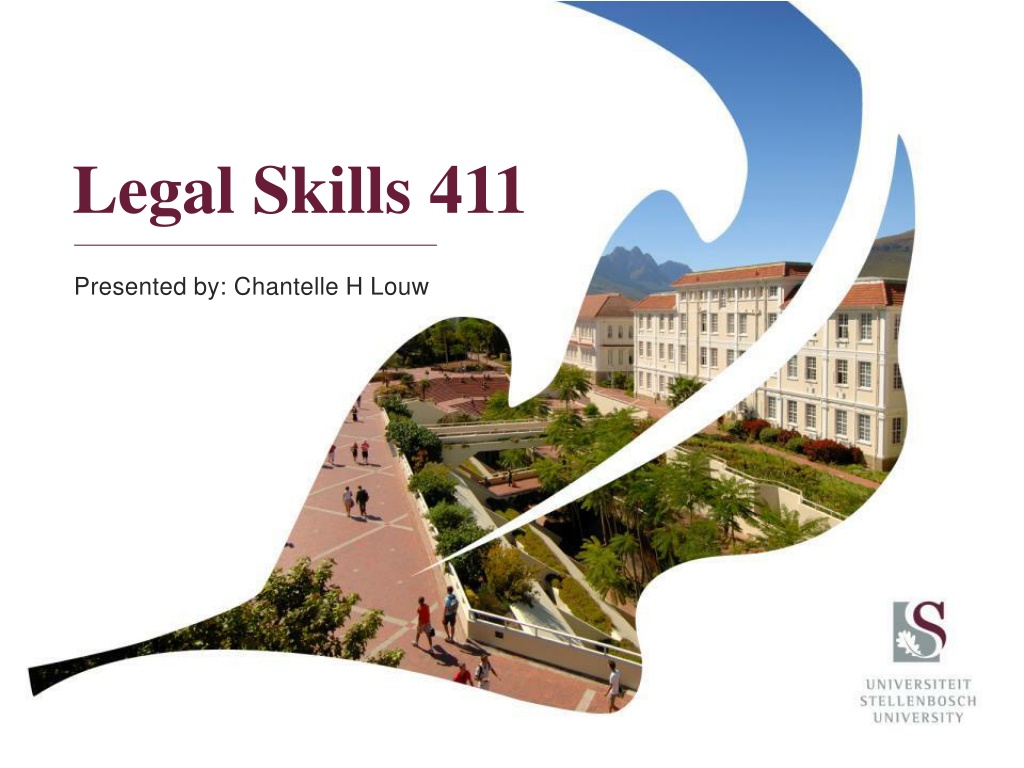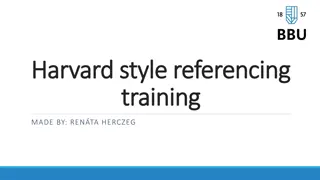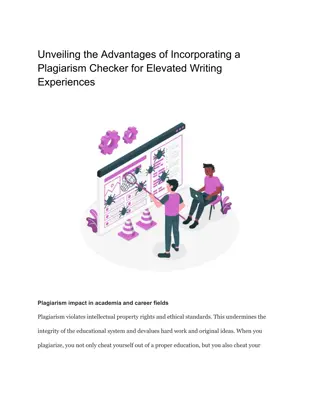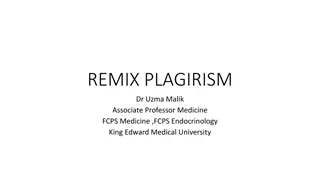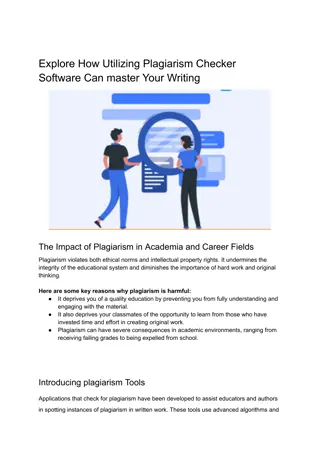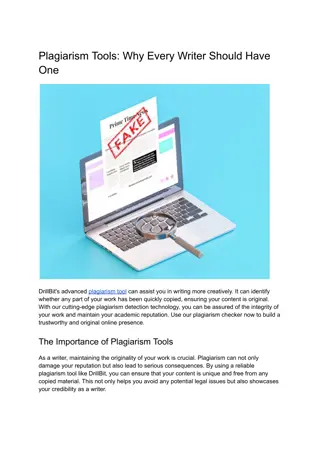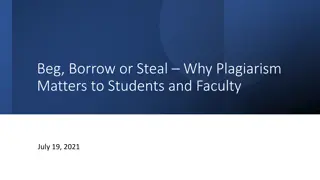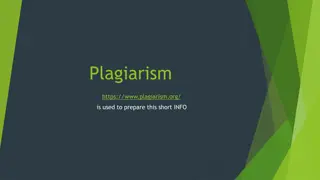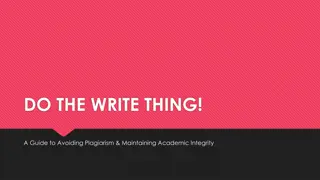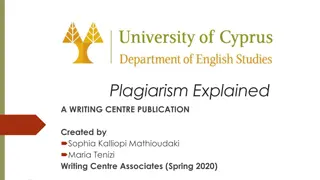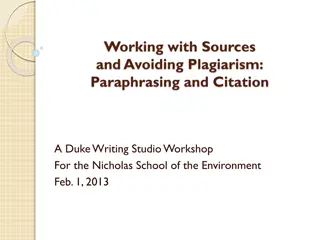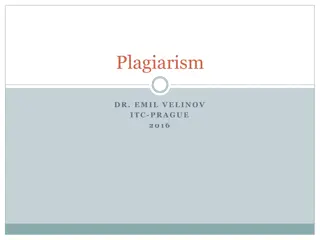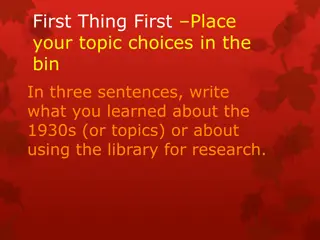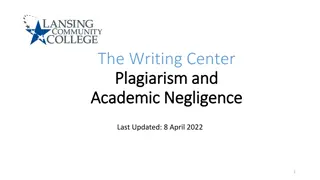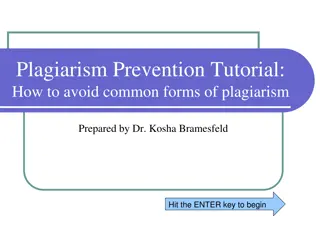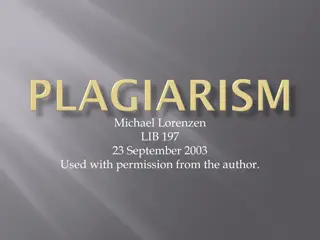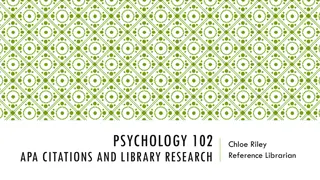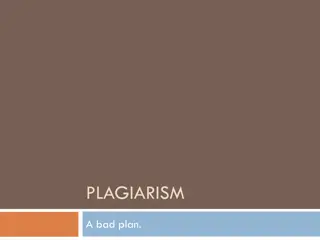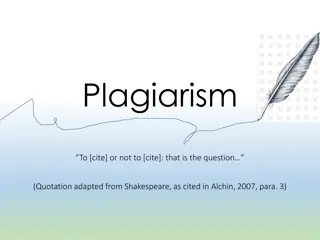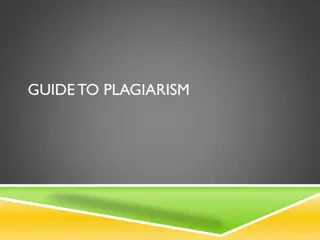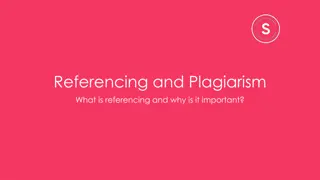Guidelines for Avoiding Plagiarism in Legal Studies
Understanding and implementing proper citation practices is crucial to avoid plagiarism in legal studies. The guidelines presented emphasize the importance of citing sources, whether it be ideas, words, or previously published work. Failure to attribute sources properly can result in academic misconduct.
Download Presentation

Please find below an Image/Link to download the presentation.
The content on the website is provided AS IS for your information and personal use only. It may not be sold, licensed, or shared on other websites without obtaining consent from the author. Download presentation by click this link. If you encounter any issues during the download, it is possible that the publisher has removed the file from their server.
E N D
Presentation Transcript
Legal Skills 411 Presented by: Chantelle H Louw
Plagiarism During the course of your studies at the Faculty of Law (the Faculty ), you will be exposed to the intellectual work, products or expressions of others. In an attempt to assist you to eliminate plagiarism and to promote academic integrity, the Faculty has compiled these guidelines. NEW plagiarism policy: http://www0.sun.ac.za/research/policies-and-guidelines.html. Defines plagiarism as: use of the ideas or material of others without The acknowledgement, or the re-use of one s own previously evaluated or published material without acknowledgement (self-plagiarism).
Avoiding plagiarism: General guidelines To avoid committing plagiarism you can use these rules of thumb: if it is not your own ideas(s), cite; if it is not your own words, quote and cite; if it is your own, previously presented, marked or published work, cite and explain use; and if in doubt, cite.
Guidelines A. Verbatim copying without quoting and referencing Excerpt from original source: Upon attaining majority, the former minor may ratify a contract he or she initially concluded without the requisite assistance, with the result that the contract becomes fully enforceable with retroactive effect. How it should be referenced: When a minor reaches majority in South Africa, that is 18 years of age, he or she may ratify a contract he or she initially concluded without the requisite assistance, with the result that the contract becomes fully enforceable with retroactive effect. 1 1 J Heaton The South African Law of Persons 3 ed (2008) 98.
Guidelines B. Sources translated from English to Afrikaans or vice versa English source: Parties must adhere to a minimum threshold of mutual respect in which the unreasonable and one-sided promotion of one s own interest at the expense of the other infringes the principle of good faith to such a degree as to outweigh the public interest in the sanctity of contracts. [R Zimmermann Good Faith and Equity in R Zimmerman & D Visser (eds) Southern Cross: Civil and Common Law in South Africa (1996) 259 259-260.]
Guidelines How it should be referenced: Partye moet n minimum drumpel van wedersydse respek nakom waar die onredelike en eensydige bevordering van een party se eie belang ten koste van die ander, die beginsel van goedertrou in so n mate skend dat dit swaarder weeg as die openbare belang in die onskendbaarheid van kontrakte.2[eie vertaling] Footnote: 2R Zimmermann Good Faith and Equity in R Zimmerman & D Visser (eds) Southern Cross: Civil and Common Law in South Africa (1996) 259 259-260.
Guidelines C. Paraphrasing Excerpt from original source: Even if the defence of disciplinary chastisement were effectively to disappear the defence of mistaken belief that moderate corporal chastisement for educational purposes is allowed (that is, putative disciplinary chastisement), being a defence excluding fault in the form of knowledge of unlawfulness, might still be available in principle. [JM Burchell Principles of Criminal Law 4 ed (2013) 202.]
Guidelines How it should be referenced: Although the defence of disciplinary chastisement might disappear, the misguided belief that reasonable physical punishment used for educational purposes is permitted, this being a defence not including liability in the form of knowledge of unlawfulness, might still exist in principle.1 Footnote: 1JM Burchell Principles of Criminal Law 4 ed (2013) 202. NB! Be careful of find and replace where you merely use synonyms for each word in your original text. That s NOT paraphrasing.
Guidelines D.Providing false / non-existent references This could include, inter alia, footnotes that contain false or non- existent references, for example, URL s of websites, authors, sources, page numbers, etcetera and also constitute acts of plagiarism. E. Using the written assignments / essays / research papers or tutorials answers of another student(s) Using a fellow student s (or students ) written assignment(s) / essay(s) / research paper(s), tutorial answer(s) or any part thereof, of any prior or current year of study, with or without the student s (or students ) consent and presenting it as your own work constitutes plagiarism.
Recommendations Recommendations and techniques on how to avoid plagiarism: Planning your assignment / research paper is the first step to avoid plagiarism. By planning ahead you know that you will be using sources other than your own ideas and can therefore already start to plan how you will incorporate these sources into your assignment / essay / research paper. Take notes while conducting research and record your sources accurately and completely. You could even include notes to identify whether you intend to use a source verbatim or by paraphrasing so that you would remember to insert quotation marks in the case of verbatim use. This is very important!
Recommendations Do not copy and paste any content from your research directly into your own assignment / essay / research paper. Rather make notes on a separate document and record the source accurately. Where possible, print your sources so you can refer to it again later, or save them in a folder on your computer using the author and title of the source as a file name. Read your researched sources repeatedly until you understand them and how you want to use them in your own assignment / essay / research paper. When summarise, do so without referring back to the original source but remember to still acknowledge the source(s). you then paraphrase or
Recommendations Err on the side of caution - when you are unsure whether an idea in your essay / research paper is your own or originated from a source you have read, rather cite the source. Refrain from reading a fellow student s (or previous year s student s) assignment / essay / research paper for inspiration . Learn how to paraphrase properly. When you translate a source, remember to reference the source and to add [my translation] after the translated text.
Recommendations If you are unsure whether to reference a source, ask your lecturer, the lecturer s assistant or a writing consultant. Use Turnitin. It will identify those sections in your work where you have used sources from elsewhere and you can make sure that you have referenced those sections accurately. NB! http://blogs.sun.ac.za/legalwriting/files/2017/01/FINAAL_Plagiaa triglyne.pdf (Afrikaans) http://blogs.sun.ac.za/legalwriting/files/2017/01/FINAL_Plagiaris m-guidelines.pdf (English)
Dankie Thank you Enkosi
